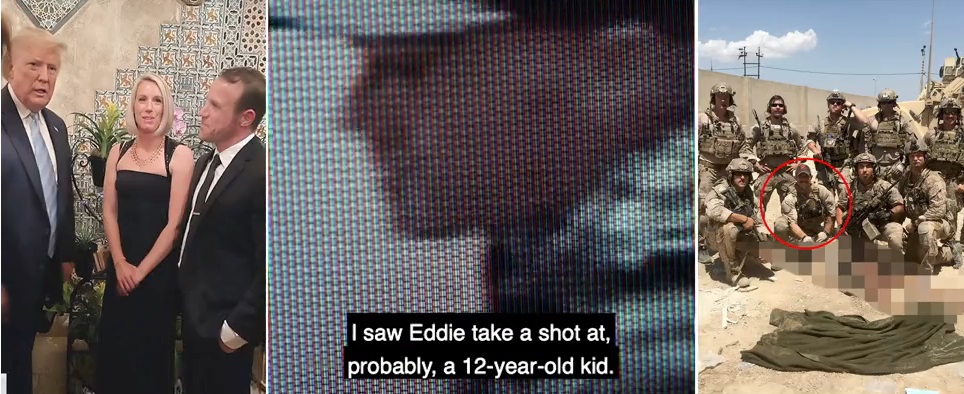Donald Trump calls him a hero, but Edward Gallagher’s platoon Navy SEALS chillingly described him as ‘freaking evil’, ‘toxic’ and trigger-happy in previously unseen video interviews with investigators ahead of his war crimes trial.
The SEALS were interviewed by naval criminal investigators before Gallagher was charged in September 2018 – and then later acquitted – of war crimes, including the murder of a wounded ISIS fighter in Iraq.
The video recordings of their interviews were leaked to the New York Times and are now shown publicly for the first time in its The Weekly documentary series.
In addition to the video interviews, combat footage and text message exchanges between the SEALS were also released.
They were all part of the investigative files used in Gallagher’s high-profile trial this summer.
The war crimes case against Gallagher drew the attention of Trump who regularly tweeted his support and then later intervened.
The interviews painted a picture of Gallagher, who was their platoon chief during a 2017 deployment to Iraq, being a reckless leader who had a hunger for violence.
‘The guy is freaking evil,’ Special Operator First Class Craig Miller told investigators during his interview.
In a separate interview, Special Operator First Class Joshua Vriens said: ‘The guy was toxic.’
Special Operator First Class Corey Scott, who was a medic, was recorded saying: ‘You could tell he was perfectly okay with killing anybody that was moving.’
‘I think he just wants to kill anybody he can,’ Scott added elsewhere in his interview.
Some described him as ‘getting crazier and crazier’ and also that they’d heard rumors of Gallagher ‘targeting civilians’.
‘I saw Eddie take a shot at, probably, a 12-year-old,’ one said in their interview.
Three SEALS told investigators in their interviews that they saw Gallagher stab a wounded ISIS fighter in the neck during a 2017 deployment to Iraq.
‘I saw it happen,’ Petty Officer 2nd Class Ivan Villanueva said in his interview.
It was these interviews that led to Gallagher being charged with murder.
Gallagher has always maintained that the charges brought against him were made up by six members of his platoon who wanted to force him out.
Scott, one of the SEALS who was interviewed in the videos, later changed his story when he was called to testify during Gallagher’s trial.
He had told the investigators that he saw Gallagher stab the wounded ISIS fighter multiple times before he died.
At the time, Scott and Gallagher were treating the fighter after he had been injured in an airstrike.
During the trial, Scott changed his story and admitted to suffocating the fighter by covering his breathing tube after Gallagher only stabbed him once.
Some of the SEALS who were interviewed by investigators were never called to testify during Gallagher’s trial.
Following the trial, a military jury acquitted Gallagher of all war crimes charges except one, posing in photos with the dead captive.
Gallagher’s case drew widespread controversy with President Trump repeatedly intervening on his behalf.
Gallagher was demoted but was later allowed to keep his Trident Pin and retire a SEAL following Trump’s intervention.
Just this week, Gallagher and his wife Andrea were pictured meeting with Trump and First Lady Melania at Mar-a-Lago.
The couple wrote on their shared Instagram account Saturday night: ‘Finally got to thank the President and his amazing wife by giving them a little gift from Eddie’s deployment to Mosul. #TRUMP2020 @realdonaldtrump @flotus.’
Trump took an interest in the case after Bernard Kerick, a former business partner to Trump personal lawyer Rudy Giuliani, became an advocate for the family and made appearances in conservative media.
He tweeted in support of Gallagher, praising the sailor’s service to the country and saying the case was ‘handled very badly from the beginning’.
Shortly after the trial, Trump got involved again by ordering the Navy to withdraw commendations that prosecutors received for their work.
Trump last month directed the Navy to restore Gallagher to his previous rank as he issued pardons to two Army soldiers.
The Navy’s top SEAL, Adm. Collin Green on November 19 notified Gallagher that he would be undergoing a peer-review process to determine whether he was still suitable to be a SEAL. Three other SEAL officers who oversaw Gallagher during the Iraq deployment also were notified they were being reviewed.
Then, at the end of November, Trump gave Defense Secretary Mark Esper a direct order to allow Gallagher to retire without losing his SEAL status.
US Navy Secretary Richard Spencer, who was fired from his position, publicly disagreed with that decision.
Angered by Trump’s interference in disciplinary matters, Spencer wrote a stinging letter, which read: ‘I no longer share the same understanding with the Commander in Chief who appointed me, in regards to the key principles of good order and discipline.’
Trump tweeted: ‘Eddie will retire peacefully with all of the honors that he has earned.’
Defense Secretary Mark Esper said he had asked for Spencer’s resignation ‘after losing trust and confidence in him regarding his lack of candor over conversations with the White House,’ the Department of Defense said in a statement.
Trump continued to defend his decision on Gallagher, stating: ‘I think what I’m doing is sticking up for our armed forces. And there’s never been a president that’s going to stick up for them and has like I have’.
His actions on behalf of Gallagher and the two soldiers have dismayed some military officials, who fear the actions undermine the military justice system.
Some believe Trump should not have used his authority as commander in chief to erase the sentence handed down by military jurors who convicted Gallagher of posing with a dead Islamic State captive.
Jurors recommended that he be demoted.

